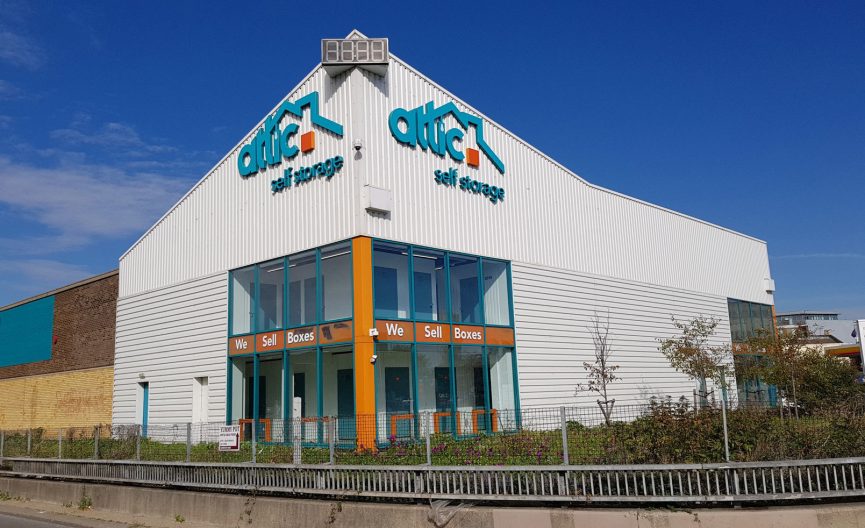A few weeks ago – sorry for the delay – we left off at Bow Bridge (like London Bridge it has long since fallen down and been replaced by a flyover).
Today, like the whole of the world it seems, we’re striking out in a new, somewhat unfamiliar, direction.
Leave the welcoming air-conditioned womb of Attic Self Storage’s Wick Lane reception, pausing only to grab a handful of complimentary sweets ‘for the kids’ (yeah, right), and make your way out of our imposing security gates. It’s alright, you’re quite safe.
Although, with the English summer upon us, you might need a brolly.
Stop for a moment. Look beyond the delightfully appointed Shell garage opposite and you’ll see a strange sign on the battered exterior of an old factory building:
PERMANITE. Oh, the bitter-sweet irony.
Nothing, it seems, lasts forever. This former home of an asphalt roofing company now houses ‘Foundry’, an independent design agency. But we’re happy with the size and shape of our logo, so that’s not where we’re heading.
Take The Bee Road
Turn right, past our blossoming wildflower garden, and let the scent of the lavender and the soft drone of the foraging honeybees soothe your spirits before you make your way over the roar of the conveniently placed A12.
Head straight across two sets of traffic lights (please wait for the off-ramp cars to stop) and you’ll find yourself in Tredegar road.
Come on, quit dawdling! We’re nearly there.
When you reach the mini roundabout near the Heart of Bow sign, hang a left and carry on down Fairfield road.
Keep going until you see the imposing red brick buildings, towers and soaring chimneys of the much sought after gated community known as Bow Quarter. Home to hipsters, high priced housing and a whole heap of history.
On the left, you’ll find a blue plaque on the wall:
But the words don’t tell the whole story. Allow us to elucidate…
Unsafety Matches: The Girls Go On Strike
Early in 1888, the same year that Jack The Ripper was slashing his way around Whitechapel and Aldgate, there was a different sort of death being dispensed further east. This sprawling 7-acre complex was known as The Fairfield Works – the Bryant & May match factory.
In the 1880s Bryant & May employed nearly 5,000 people, mostly women and many of them small girls. While Attic Self Storage insist on paying all our staff the London Living Wage, these poor workers survived on a pittance and had to provide glue and string from their own funds.
The manufacturing process involved using highly toxic white phosphorus and many women suffered from ‘Phossy Jaw’ as a result. This horrific condition (which the management were well aware of) manifested itself initially in toothaches and flu-like symptoms, then tooth loss, abscesses, swelling of the gums, and eventually brain damage and multiple organ failure.
According to one eyewitness, when the women left the factory after working their normal 14-hour shifts, their facial bones glowed a greenish-white in the gathering dusk.
Mortality was reported in around 20% of cases. Eventually the appalling conditions led the women to ‘get up, stand up’ for their rights.
Take Me To Your Leader
132 years ago, on a sweltering hot July day, over 1,400 Matchgirls, led by Sarah Chapman, rose from their cramped work benches and walked out.
A few days later, with the management refusing to listen to their long list of grievances, they marched from Bow to Whitechapel and on towards The City of London. It was only then that the Social activist, Annie Besant, got involved, after somewhere around 100 of the women, who were granted an audience, begged for her assistance.
It’s simply not true that she started or led the strike. It seems that Besant was, in fact, rather dismayed when she was confronted by this rowdy army of out-of-work women, with no shoes, seemingly no fear and definitely no means of financial self-support.
But Annie had friends in high places. She brought pressure to bear on Mr. Bryant and Mr. May; questions were asked in Parliament; the entire East End rose up in support of the strike; B&M match sales collapsed.
With Besant brokering a deal, the management were forced to come to terms with the striking Matchgirls and it was agreed that any fines, deductions for the cost of materials and other human rights violations would be addressed.
It was also decided that in future, meals should be taken away from the factory floor, where the food would not be contaminated with poisonous phosphorus. The strike was finally over, but it had succeeded in lighting the fuse for industrial action and improved worker’s rights the length and breadth of this little island.
Just recently, in May 2020, it came to light that Manor Park Cemetery had been trying to move the interred remains of Sarah Chapman from her pauper’s grave. Once again, the East End is up in arms in defence of one of the main leaders (but lesser known names) of the strike that changed the course of the industrial revolution in Britain.
Why Has Gladstone Got Blood On His Hands?
There’s an interesting aside to this story, in the shape of the statue of William Ewart Gladstone in the middle of Bow Road, standing in the shadow of the sprawling edifice that is Bow Church (now the site of one of the local Food Banks that Attic are proud to support).
Theodore H. Bryant, co-owner of the nearby match factory, commissioned Albert Bruce-Roy to make a statue of the then Prime Minister. This supreme act of toadying was completed in 1882 and was presented as ‘a gift to the east of London.’
In the build-up to the statue’s unveiling, rumours circulated that it had been paid for by docking a shilling from the wages of the underpaid female factory workers; many only children, all on starvation wages, unshod through winter, glowing in the dark, and still six years away from their landmark strike.
Writing after the fact in 1888, Annie Besant (again) painted a vivid picture of the mood of the workers forced to attend the unveiling:
‘So furious were the girls at this cruel plundering, that many went to the unveiling of the statue with stones and bricks in their pockets… Later they surrounded the statue – “We paid for it”, they cried savagely, shouting and yelling, and a gruesome story is told that some cut their arms and let their blood trickle on the marble paid for, in very truth, by their blood.’
Ever since, the hands of the statue are regularly daubed with red paint as a tribute to their sacrifice. Cleaning Gladstone’s palms remains a futile task. The bronze was scrubbed in the build-up to the 2012 Olympics, and by the next morning the offending ‘Alice Bands’ (for those unfamiliar with cockney rhyming slang – “hands”) were freshly coated in crimson. What a bloody brilliant act of defiance! Yes, the marks always come back – a symbol of solidarity with the oppressed, underpaid, downtrodden and abused.
Our Place On The Poverty Map
Another c19th social reformer, Charles Booth, drew up a famous ‘Poverty Map’ measuring how deprived or well-off households were on a street-by-street basis. He started his work in 1886 and spent 15 years adding to it, revealing the varying levels of deprivation across London.
Contrary to what you might think about the abject poverty of the Victorian era East End, the area surrounding Attic Self Storage in Wick Lane is highlighted in red, meaning ‘middle-class and well-to-do’; whereas other areas nearby are shaded dark blue for ‘very poor, chronic want’ or black indicating ‘lowest class, labourers, street sellers, criminals & semi-criminals’.
Unfortunately, even today, Tower Hamlets is home to some of the poorest people in England. According to a 2018 council document, the borough has the highest rates of child poverty in the whole of the UK. 31% of children live below the poverty line.
The East London Federation Of Suffragettes
The East End has always been a hot bed for radical activity. The HQ of the East London Federation of Suffragettes was founded in 1913 at 400 Old Ford Road. They did much to help local people, providing food and work.
Many local women got involved – Mrs Savoy, a Brushmaker, was one of the Deputation of East End women who went to Downing Street in 1914. On her death, Sylvia Pankhurst wrote: ‘The streets of Old Ford are colder and greyer with her loss’.
The Suffragette newspaper, Women’s Dreadnought, was published from 321 Roman Road and rolled off the press of a print shop a few doors down.
They raised funds for the cause by running a stall in the market selling their publications, toys made in their East London Toy Factory at 45 Norman Grove, and second-hand goods.
The Battle Of Bow Baths
Regular meetings were held at Bow Baths (so badly damaged by Luftwaffe bombing in WW2 that it never reopened and was demolished).
On 13 October 1913, Pankhurst, who had been banned from appearing in public, went in disguise to address a rally there.
The police were tipped off, but when they sprang on stage to arrest her, the audience screamed “Jump, Sylvia, jump!”, and she did – right into their outstretched arms. The police tried to push through, smashing chairs and shoving people out of the way, but Pankhurst managed to escape in someone else’s hat and coat.
A few weeks later, the press reported ‘The Battle of Bow’ in which a police officer was charged for assaulting a labourer supporting a Suffragette demonstration.
But when the First World War broke out, the supporters of female suffrage stopped most of their campaigning.
However, a change came after hostilities ceased. Women had contributed greatly to the war effort and kept the country going while the men were away. In 1918, the government passed the Representation of the People Act giving the vote to all men over the age of 21 and women over the age of 30 who were householders or married to a householder.
The campaign for women’s suffrage finally achieved ultimate success in 1928, when women were granted exactly the same voting rights as men.
We’re happy to report that Attic Self Storage has always had women at the heart of our business, with women in charge of finances, marketing and management roles at each of our 3 (soon to be 4) stores.
At The End Of Our Wick
If you turn hard left (which seems rather appropriate in the context of this particular blog) out of Attic Self Storage HQ and continue down Wick Lane, parallel with the A12, you will pass the area known as Fish Island and end up in the ever-so trendy Hackney Wick.
Back in the day, The Wick was notorious for its jerry building, and was described in 1879 as ‘a district of 6,000 people who have sunk to the lowest depths’. For what it’s worth, a Salvation Army report in 1897-8 found the drifters and downtrodden in the area to be ‘less violent than those of Bethnal Green’; whilst the local Eton College Mission, despite lavish expenditure, had little moral influence.
The Oldest House In Hackney
If your feet don’t hurt too much by now and you’re happy to carry on, you’ll find something else extraordinary waiting for you just up the road.
Sutton House is Hackney’s oldest domestic building and one of the few urban properties owned and maintained by the National Trust.
Three-storeys tall, built of brick on an H plan for Sir Ralph Sadler in the 1530s, the building retains some of its original exterior ‘diaper’ brickwork and its early interior decoration and fittings.
Only one original window, of six lights with a single transom, survives. The staircase in the west wing is 17th-century. The house was divided into two dwellings around 1752, when the central range was refaced and given sash windows and a second doorway, and sash windows were put into the fronts of the wings. The east wing was rendered in the later 19th century when there was some interior re-modelling. Additions to the south culminated in a large meeting room, the Wenlock Barn, of 1904.
Restoration, begun in 1990, has aimed to display the Tudor house in its undivided state while adapting the additions of the early 1900s for use by the community. The building was reopened to the public in 1992.
Attic Self Storage were to be the proud sponsors of Sutton House’s entire programme of events for 2020, but sadly with the Covid-19 crisis, the doors have been pretty much locked and bolted to the public since March.
Hopefully things will open up soon.
In the meantime, you are welcome to visit Attic in Bow for all of your modern storage – and ancient history – needs. We have remained steadfastly open for business throughout the lockdown. You are most welcome to make the most of our facilities 24 hours a day, 7 days a week, 365 days a day. Especially if you’re a woman.
Join us as we resume our ongoing history tour next with a look at the industrial past, modern graffiti and ‘urban regeneration’ of the artist’s quarter that is also right on our doorstep.
To be continued…




